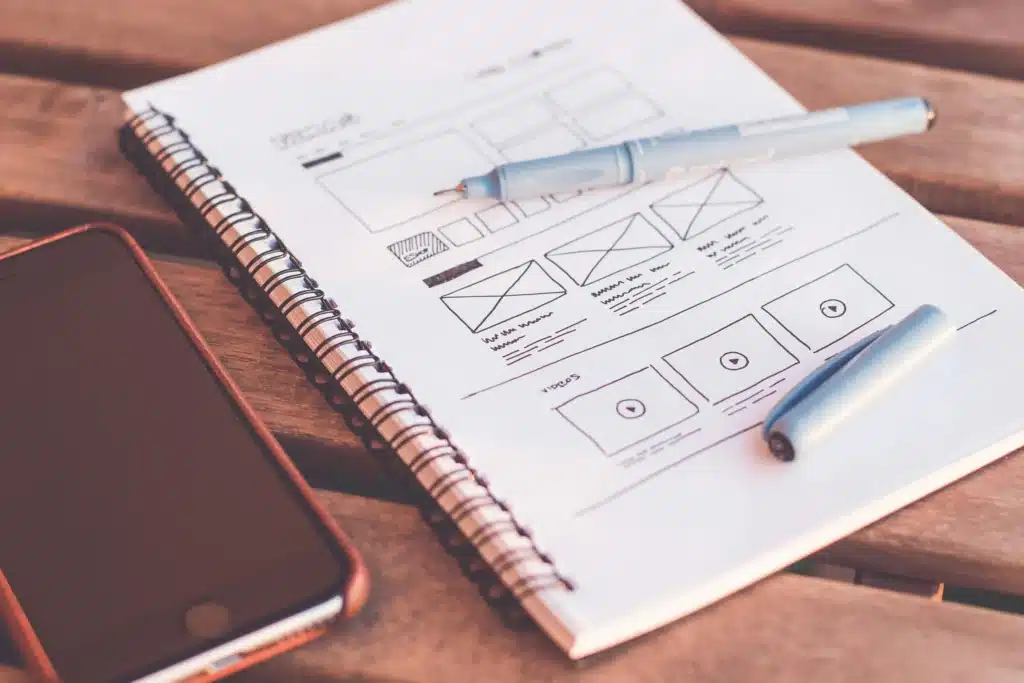
The design of a mobile application has the power to make or ruin a user’s experience. With millions of mobile apps available, developers cannot take the risk of not doing their best to develop outstanding mobile applications.
Nowadays, with hundreds of similar apps competing within the same niche, people anticipate quick performance, aesthetically pleasing interfaces, and easy navigation. If yours falls short of these expectations, they will quickly move to a competitor’s app.
When developing your apps, you must implement proven mobile app design best practices to guarantee an engaged audience, usability, and retention, whether creating a new app or improving an existing one.
We’ll examine some of these proven mobile app design best practices, which will help you create an app that looks amazing, works well, and attracts consumers.
RELATED BLOG POSTS
- 5 ESSENTIAL ELEMENTS OF UX DESIGN IN WEBSITE DEVELOPMENT
- 9 EXPERT TIPS TO OPTIMIZE YOUR WEBSITE’S MOBILE RESPONSIVENESS
- A COMPLETE GUIDE TO ANGULAR UNIT TESTING IN APP DEVELOPMENT
- 7 GAME-CHANGING UPDATES FOR FRONTEND DEVELOPERS-CHARISOL
What Is Mobile App Design?
Mobile app design is the process of creating user-friendly, functional, and visually appealing interfaces for applications on mobile devices.
A good mobile app design does not just focus on aesthetics but also on creating a complete user experience. It allows for easy interaction, from design to features and interactive elements.
Think of it like designing the interior of a car: you need to consider the aesthetics of the dashboard and seats, the placement of controls, the comfort of the driver, and the overall driving experience.
Similarly, mobile app design focuses on all aspects of the application, including the layout, navigation, and interactive elements, ensuring that users can easily find what they want.
Why Does Mobile App Design Matter?
As explained earlier, mobile app design isn’t just about making an app look pretty; it involves several functionalities critical to its success.
Before we dive into the mobile app design best practices, here’s why following them is so important:
1. Increased user experience
When using mobile apps, users form opinions within seconds, and according to a study, first impressions are usually influenced by the visuals of the mobile application.
A visually appealing mobile app design creates a positive first impression, encouraging users to continue using the app. It’s like walking into a clean, organized, and attractive store.
Because of the organized layout, much more will catch your attention, even if you’re just exploring.
Conversely, a poorly designed app can create instant frustration, leading to users uninstalling or unsubscribing.
2. User retention
The features and functionalities of a mobile app have to be straightforward so that users can easily find what they’re looking for and complete tasks efficiently.
Visitors or users are more likely to return and recommend the app to friends when this is in place.
Alternatively, a confusing design with complex features can lead to frustration and abandonment.

Photo by Towfiqu barbhuiya on Pexels
3. Increased conversion rates
Whether purchasing, signing up for a service, or completing a form, a well-designed app can significantly impact conversion rates.
I remember downloading a mobile gaming app. From the design to the guides, storyline, and other features, I was impressed with the app to the point where I made in-app purchases and left a review on the Google Play Store—something I had never done before.
A clear and carefully designed app can influence users to take the desired actions, maximizing conversion.
The reverse is the case for confusing designs.
4. Increased engagement
Good mobile design makes the app interesting. It uses animations, clear calls to action, and optimized user flow to keep users involved and engaged with the application. When users are involved, they spend more time using the app.
I’ve spent sleepless nights with the gaming app I mentioned earlier, and that’s just one of the few apps that can keep me awake for an extended period.
5. Competitive advantage
Implementing some mobile app design best practices will make you stand out in the competitive market.
A well-designed app stands out, attracting users and building brand loyalty.
No amount of marketing can substitute for a good user experience in mobile applications. Yes, you can make users download the app, but only a great experience will keep them from uninstalling it.
6. Customer satisfaction
Mobile app design contributes to overall customer satisfaction. When users have a positive experience with your app, they’re more likely to recommend it to others and become loyal customers.
Top Mobile App Design Best Practices
Here are some of the top mobile app design best practices you need to implement today:
1. Keep it simple and intuitive.
One of the most fundamental mobile app design best practices is to prioritize simplicity.
Having a complex design can confuse users. Users generally expect to navigate apps effortlessly.
Avoid clutter and unnecessary complexity in functionality. Focus on clear language and navigation options.
Think of it like a well-organized toolbox; everything has its place, and you can easily find what you need.
2. Prioritize user-centered design (UCD).
Effective mobile app design best practices always place the user at the center of the design process.
The point is not for you to showcase how good of a developer or designer you are, but to focus on how a user can interact freely and easily with the application.
User-centric design involves understanding your target audience’s needs, preferences, and behaviors. You can conduct user research, create user personas, and test your designs with real users.
3. Optimize for mobile responsiveness.
As screen sizes and device orientations vary significantly, adhering to mobile app design best practices means ensuring your app is responsive on different devices.
Your app should adapt to different screen sizes and orientations, providing a consistent and optimal user experience across all devices.
This can involve using flexible layouts, scalable images, and responsive typography.
The point is to ensure the app experience doesn’t decline when used on another device or orientation.
4. Use consistent UI elements.
Maintaining consistency in UI elements is vital to mobile app design best practices.
Consistent use of buttons, icons, fonts, and colors is crucial because it makes it easier for users to navigate and understand your app.
Consistent design also reduces the time it takes to get familiar with the app and enhances the overall user experience.

Photo by picjumbo.com on Pexels
5. Enhance navigation and accessibility.
Focus on clear and intuitive navigation. Users should be able to find what they need easily within your app.
Good navigation also means the user can return to a previous page or move around the app without confusion.
Utilize clear labeling, logical menu structures, and easily recognizable icons.
Accessibility is also paramount. A good app design considers accessibility for all users, including those with disabilities.
This means using clear typography, providing alternative text for images, and ensuring compatibility with assistive technologies.
6. Focus on speed and performance.
High-performing apps with incredible speed are fundamental to effective mobile app design best practices.
Slow loading times will frustrate users and often lead to app abandonment. Users expect apps to load quickly and respond smoothly.
Optimize your app’s code, minimize image sizes, and leverage caching techniques to enhance performance.
7. Implement strong security measures.
Implementing robust security measures is another effective design practice to implement.
Users need to feel confident that their information is safe and secure.
Protect user data with strong encryption, secure authentication, and regular security updates. Prioritize user privacy and transparency by clearly communicating your data handling practices.
Common Mobile App Design Mistakes to Avoid
Whether you are a designer or a small business owner who outsourced to a designer, here are some common mobile app design mistakes to avoid:
- Cluttered interfaces
- Inconsistent UI elements
- Poor navigation
- Ignoring accessibility
- Slow loading times
- Ignoring iOS or Android design guidelines
- Small or difficult-to-tap buttons/interactive elements
- Poor typography
- Ignoring user feedback
- Overuse of animations
- Insufficient testing
- Not including instructions for new users
- Forgetting offline functionality
- Overlooking security
- Inconsistent color schemes
- Not optimizing the app for both portrait and landscape modes
- Unclear calls to action
- Not optimizing for touch gestures
- Lack of user research
- Overloading the UI with too many features

Photo by Pixabay on Pexels
Conclusion
Implementing the mobile app design best practices shared in this post, such as sticking to simple designs, focusing on performance, and optimizing for mobile devices, can be the major difference between a successful app and a flop.
Emphasizing performance, responsiveness, consistency, accessibility, and simplicity can help you create an app that stands out in a crowded market. App developers must understand the goal and work together to create the best user experience.
Ultimately, what matters is how well your users like your app, including design and functionality.
Need expert help for effective mobile app design? Reach out now!
READ ALSO: 10 PROVEN PRACTICES FOR MOBILE APPLICATION DEVELOPMENT

